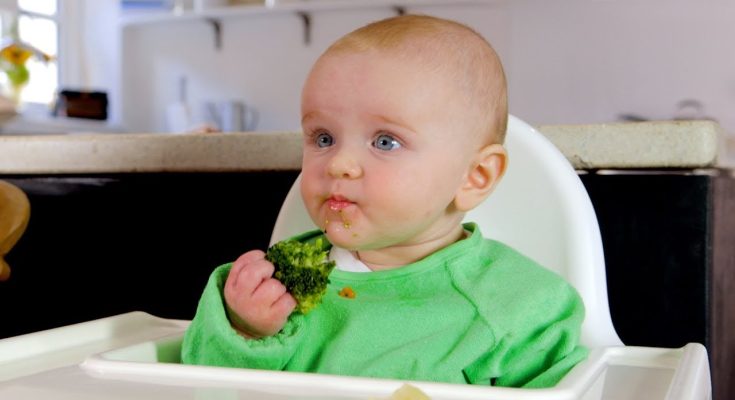Baby-led weaning (BLW) is a feeding approach that allows babies to explore solid foods at their own pace by feeding themselves from the very beginning. Instead of spoon-feeding purees, parents offer soft, age-appropriate foods in manageable sizes, enabling babies to practice self-feeding and develop essential skills.
When to Start Baby-Led Weaning
Experts, including the World Health Organization (WHO) and the American Academy of Pediatrics (AAP), recommend introducing solid foods around six months of age. However, it’s essential to look for developmental readiness signs before beginning BLW. These include:
- The baby can sit upright without support.
- The baby has good neck and head control.
- The baby shows interest in food, such as reaching for it.
- The baby has lost the tongue-thrust reflex, which pushes food out of the mouth.
If your baby meets these criteria, they are likely ready to start baby-led weaning.
Benefits of Baby-Led Weaning
1. Encourages Independence and Self-Regulation
Babies learn to self-feed, making decisions about what and how much to eat. This helps them regulate hunger and fullness cues, potentially reducing picky eating behaviors later in life.
2. Enhances Motor Skills
Grasping different textures and shapes of food strengthens fine motor skills and hand-eye coordination. It also helps babies practice the pincer grasp, a vital skill for self-feeding.
3. Exposure to a Variety of Flavors and Textures
Introducing a variety of whole foods early helps babies become accustomed to different tastes and textures, promoting a more diverse diet in the future.
4. Family Mealtimes Become Inclusive
Since BLW encourages offering baby-friendly versions of family meals, babies can participate in mealtimes, fostering social interaction and learning.
5. Supports Healthy Eating Habits
BLW helps babies develop a healthy relationship with food, allowing them to eat according to their needs and avoiding force-feeding.
How to Start Baby-Led Weaning
Choosing the Right Foods
Begin with soft, easy-to-grasp foods that can be mashed between your fingers. Some great first foods include:
- Steamed or roasted sweet potato sticks
- Slices of ripe avocado
- Steamed broccoli or carrot sticks
- Soft, cooked apple slices
- Banana cut into strips
- Toast strips with mashed avocado or nut butter
- Shredded chicken or soft meat
- Scrambled eggs
How to Serve Foods Safely
- Cut food into finger-length pieces to allow the baby to grasp easily.
- Ensure food is soft enough to mash with gentle pressure.
- Offer only a few pieces at a time to avoid overwhelming your baby.
- Avoid foods that pose a choking risk, such as whole nuts, hard fruits, raw vegetables, popcorn, and sticky foods like peanut butter in large clumps.
- Always supervise mealtimes and encourage the baby to sit upright while eating.
Common Concerns About BLW
Choking vs. Gagging
One of the biggest concerns parents have about BLW is choking. However, it’s important to understand the difference between gagging and choking. Gagging is a natural reflex that helps prevent choking. Babies learning to eat will gag occasionally as they get used to different textures.
To minimize choking risks:
- Avoid round or hard foods like whole grapes, hot dogs, and raw carrots.
- Encourage slow eating and avoid distractions during meals.
- Learn infant first aid, including how to respond to choking emergencies.
Nutrient Intake
Parents may worry about whether their baby gets enough nutrients. Since breast milk or formula remains the primary source of nutrition until age one, BLW complements milk feedings. However, iron-rich foods such as eggs, beans, lentils, fish, and fortified cereals should be prioritized.
Mess and Food Waste
BLW can be messier than traditional spoon-feeding. Using a splat mat under the highchair and allowing self-exploration within reasonable limits can make the process less stressful.
Tips for Success
- Be Patient and Trust the Process
Some babies take longer to get used to solid foods. Keep offering a variety of foods without pressure. - Follow Baby’s Lead
Allow your baby to decide how much to eat and avoid forcing food into their mouth. - Offer a Balanced Diet
Include a mix of protein, healthy fats, vegetables, and whole grains to ensure a nutritious diet. - Create a Positive Mealtime Environment
Sit with your baby and eat together to model good eating behaviors. - Keep Trying
It can take multiple attempts for babies to accept new foods, so keep offering without pressuring them.
Conclusion
Baby-led weaning is a beneficial and natural way to introduce solids, helping babies develop independence, healthy eating habits, and essential motor skills. By offering safe, nutritious foods and allowing your baby to explore at their own pace, BLW can be an enjoyable and rewarding experience for both baby and parents. With patience and proper precautions, this approach can set the foundation for a lifetime of healthy eating habits.



